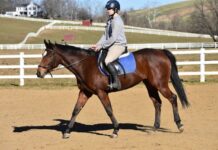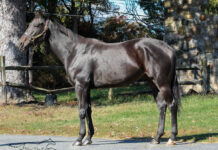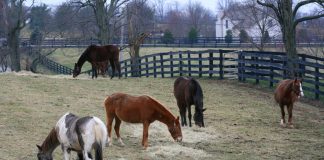 Q: I’m wanting to adopt an off-track Thoroughbred (OTTB) and help him through the last stages of rehabilitation from minor racing injuries. What are the best questions to ask the vet that has already worked with the horse in order to establish a good understanding of the current condition, as well as rehabbing steps moving forward?
Q: I’m wanting to adopt an off-track Thoroughbred (OTTB) and help him through the last stages of rehabilitation from minor racing injuries. What are the best questions to ask the vet that has already worked with the horse in order to establish a good understanding of the current condition, as well as rehabbing steps moving forward?

As a patient myself who’s presently undergoing physical therapy for an injury, one of the first things I wanted to know was what motions or movements, positions or postures were to be avoided, and for how long. For horses, this may mean stall rest, being restricted to a small paddock, or no group turnout for a while. It may also mean no exercise, handwalking only, light longeing, or light riding. If you are allowed to gently work him, be specific and ask about surfaces, inclines, figures, gaits, etc plus get an idea how long any restrictions are in place.
For myself, I also wanted to know what activities I SHOULD be doing – as well as how many and how often. In order to keep track of what your horse should and should not be doing – as well as his rehab progress – you’ll want to start a journal so that you can record what you did each day and how he tolerated it. By recording things either on paper if you’re old-fashioned like me, on your computer, or via an app, you’ll be able to look back and see when you started, say, handwalking, how long you did it, or how many laps. You can track when you added some trot steps or transitions, when you began to include bending lines, circles, and corners, when he graduated from handwalking to lunging, and from lunging to having a rider (ie weight) on his back.
Be sure to ask the vet who’s going to be working with you throughout your horse’s rehab process what problems to look for and when to contact them vs just backing off. For example, is a small amount of heat or swelling in the affected limb to be expected or should you call at the first sign of inflammation? In some situations the vet may advise taking it easy for a few days or returning to a lower level of exercise while in others an exam with imaging may be warranted.
Finally, one thing that’s different between recovering horses and humans is the concept of going “stir crazy” or having “cabin fever.” While both species certainly get antsy when they’re “cooped up,” at least humans know that it’s not forever and they can entertain themselves with TV, books, social media, etc. Horses have been known to reinjure themselves or cause a brand new injury by literally “bouncing off the walls” so if this describes your guy, talk to your vet about your options for supporting a calm temperament with supplements, feeding and management changes in the barn, or prescription medications. I hope the rehab process goes well and you have a nice partner when he’s fully cleared!





